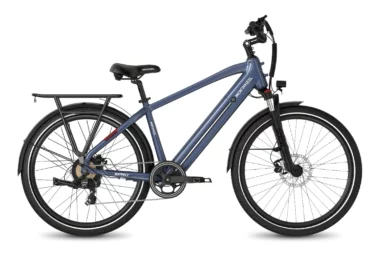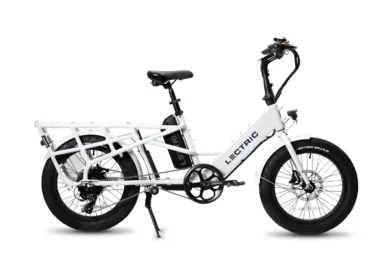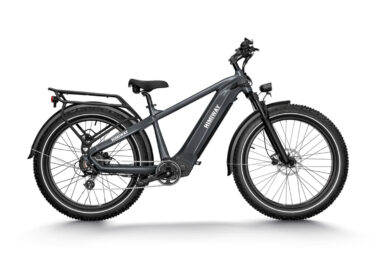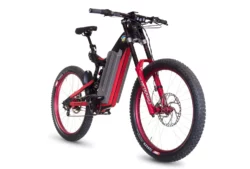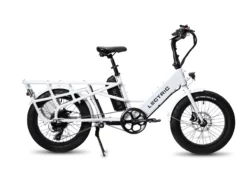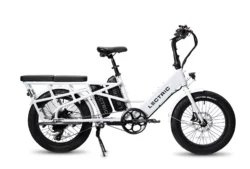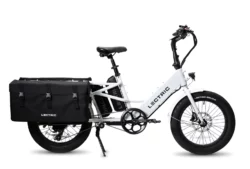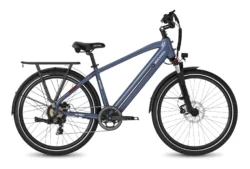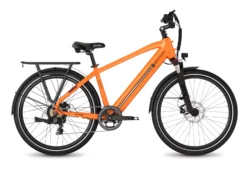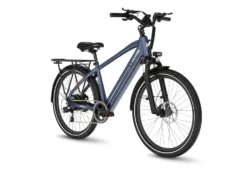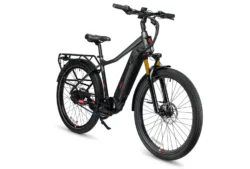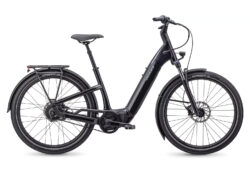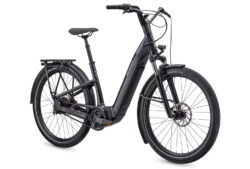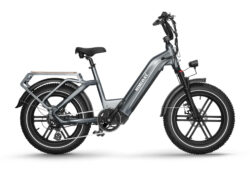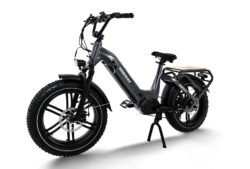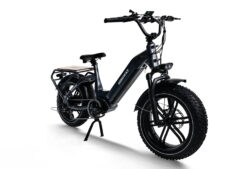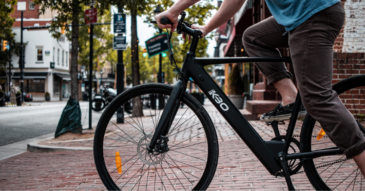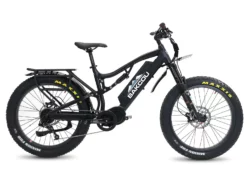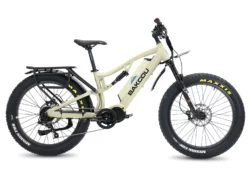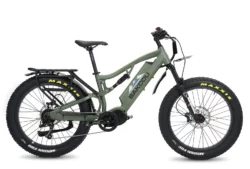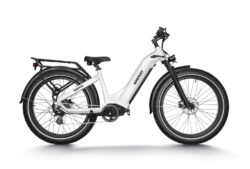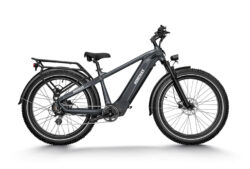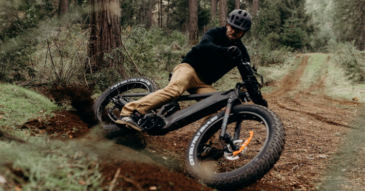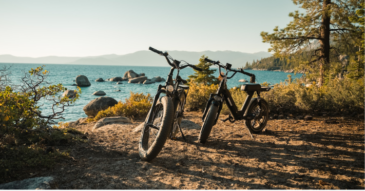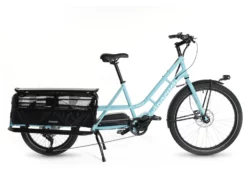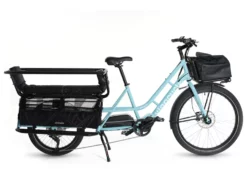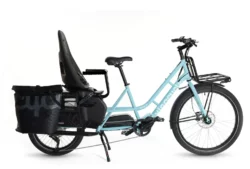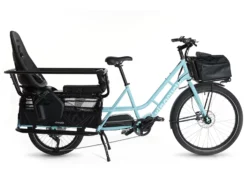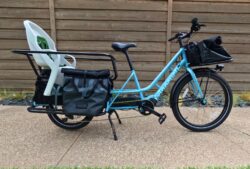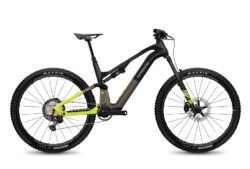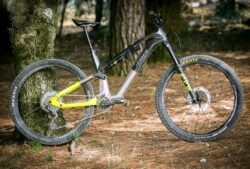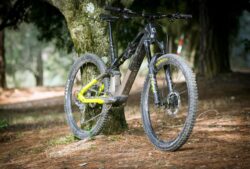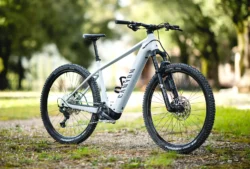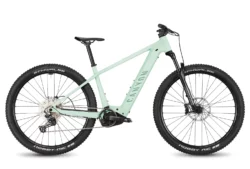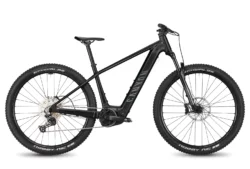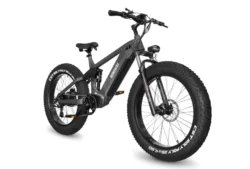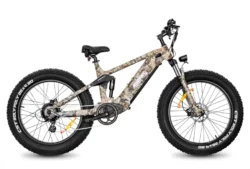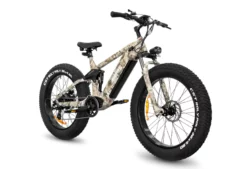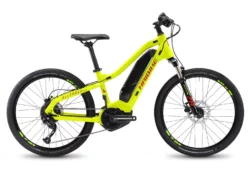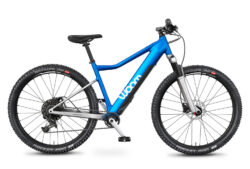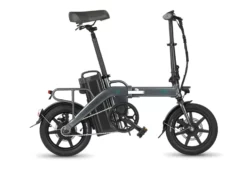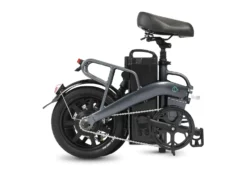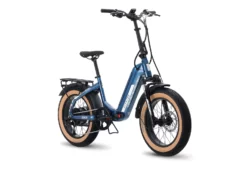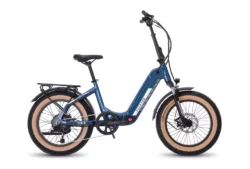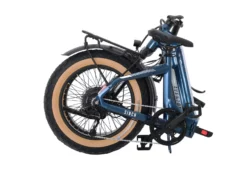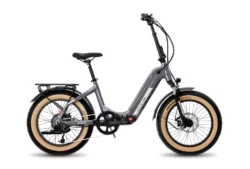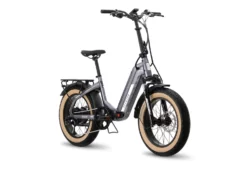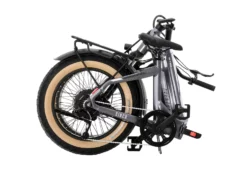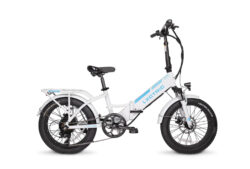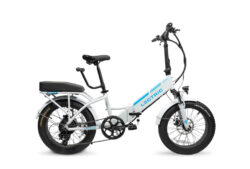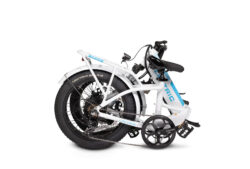How We Review Long-Range E-Bikes
We don’t just talk about long-range e-bikes; we ride them. To give you the real scoop, we put each e-bike through its paces, focusing on how far it can go. Think hill climbs and long-haul tests, all to hand you unbiased, hard data that we crunch into a straightforward 5-star rating.
Every electric bike we have hand-picked for this list has a range greater than 60 miles per full charge unless stated otherwise. We consider that a long distance.
Want to know more about who we are and how we test? Be our guest!
Best Long-Range Electric Bike Reviews
These long-range e-bikes redefine the limits of distance. The following reviews focus on the models that excel in extended range (at least 60 miles per charge), balancing power and efficiency. Ideal for almost any need you can dream up, these insights will help you land the perfect long-distance companion.
- Longest Range Electric Bike: OptiBike R22 Everest
- Best Long-Range Budget E-Bike: Lectric XPedition Cargo
- Best E-Bikes for Long Commutes: Mokwheel Asphalt, DŌST Kope CVT, Specialized Turbo Como
- Longest Range Fat-Tire E-Bikes: Bakcou Storm, Himiway Zebra, Quietkat Jeep Rubicon
- Best Long-Range Cargo Electric Bike: Xtracycle Swoop
- Best eMTBs for Long Rides: Haibike Lyke CF 11, Canyon Grand Canyon:ON, Himiway Cobra
- Long-Range E-Bikes for Kids: Haibike AllTrack Kids, Woom UP 6
- Folding E-Bikes with the Longest Range: Fiido L3 Long Range, Aventon Sinch.2, Lectric XP Step-Thru 3.0
Longest Range Electric Bike
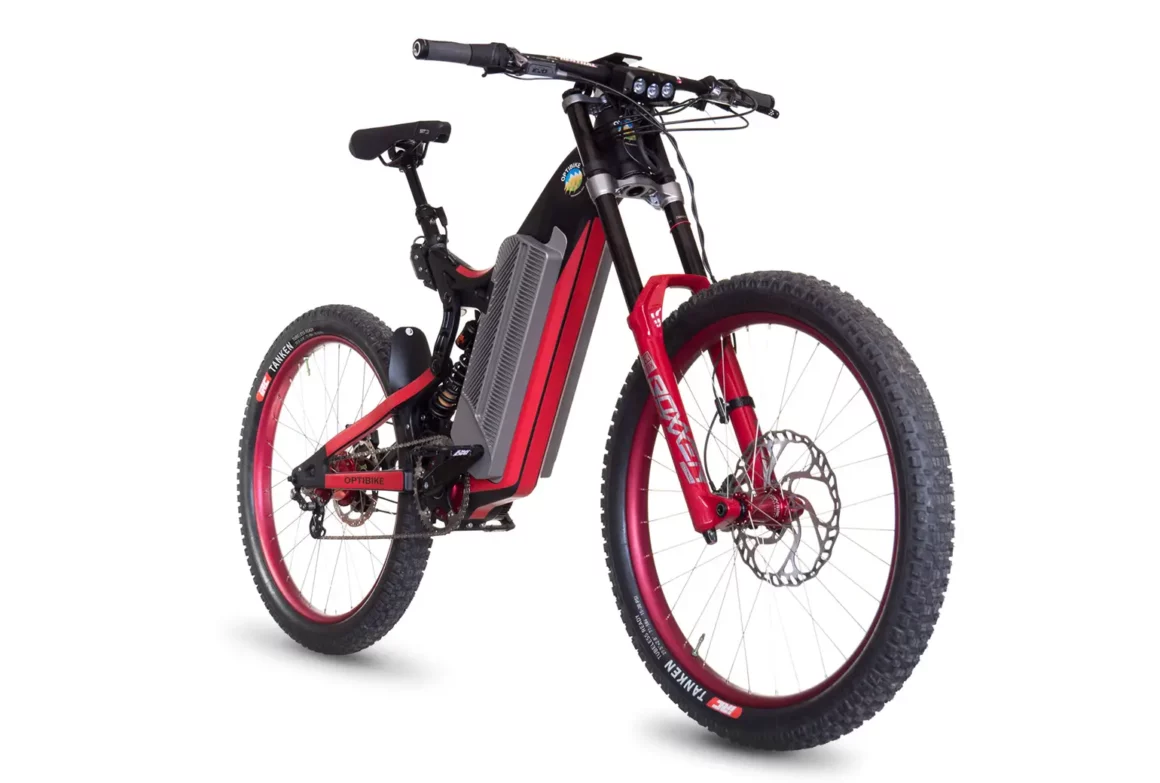
Optibike R22 Everest
What We Like
- Astounding 300-mile range for extensive adventures
- Powerful 1,700-watt motor with 190 Nm torque
- Versatile for off-road and legal street riding
- Customizable options including tires and saddles
- Rugged construction, ideal for extreme terrain
What We Don't Like
- Hefty price tag for high-end features
- Heavy at 93 lbs, challenging for some riders
- Maintenance demands due to extreme usage
Overview of the R22 Everest
The Optibike R22 Everest is designed for dead-serious off-road enthusiasts. With its massive 3.26 kWh battery, it promises an unparalleled 300-mile range, making it a beast for long-distance trail riding and overlanding adventures.
The e-bike’s 1.7 kW mid-drive motor offers exceptional power and torque, handling even the most challenging terrains with ease. It’s built to be tough, yet its internal gear system keeps chain issues at bay. While it excels in wild terrains, it can also conform to legal requirements for street riding, offering a level of versatility that’s rare in this segment.
Bottom Line
The Optibike R22 Everest stands out as the ultimate choice for riders seeking extreme performance and range in an eMTB. Its blend of power, durability, and range makes it a top pick for those that demand the best in off-road e-biking.
Best Long-Range Budget E-Bike
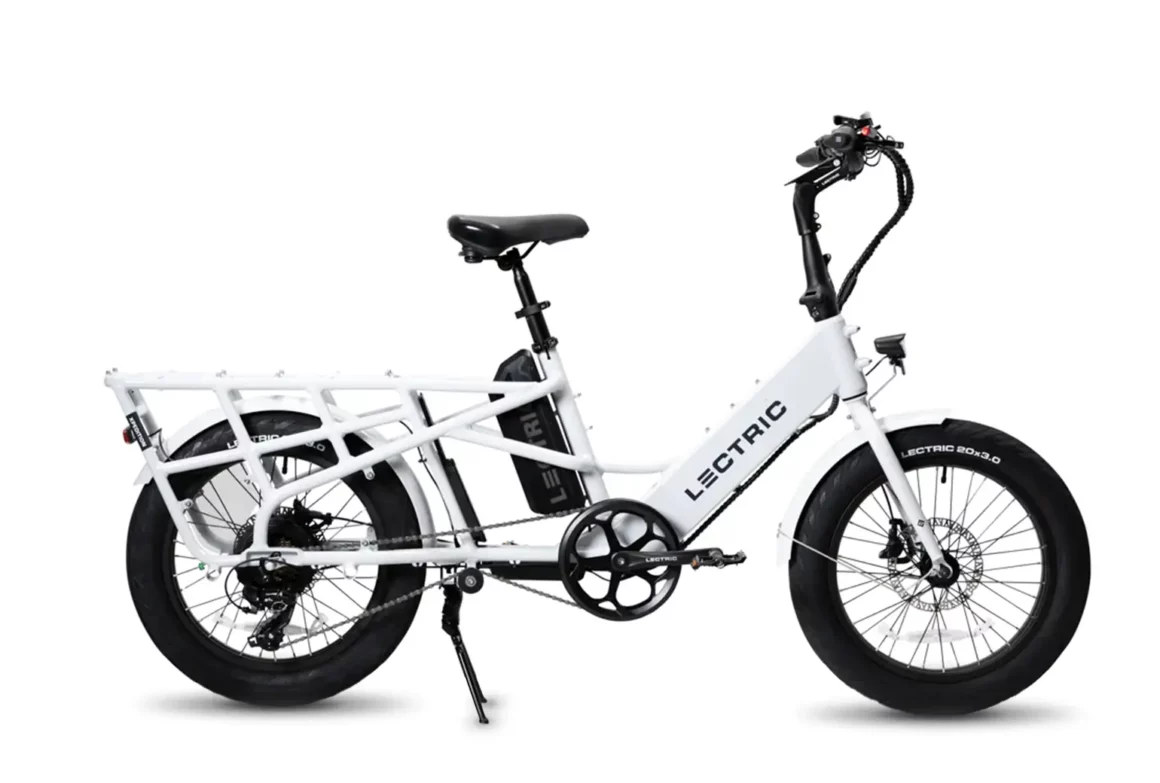
Lectric XPedition Cargo
What We Like
- Astounding 150-mile range with the dual battery setup
- Substantial 450 lbs carrying capacity
- Affordable at $1,399.00, offering great value
- Class II e-bike with throttle for easy riding
- Adjustable stem and saddle for rider comfort
What We Don't Like
- Non-big-brand components might impact durability
- Throttle mode drains battery quickly on inclines
- Less stylish compared to some competitors
Overview of the XPedition Cargo
The Lectric Xpedition stands out as a budget-friendly, long-range e-cargo bike, ideal for a variety of purposes from family use to commercial deliveries. Priced competitively at $1,399 for the dual battery version, it offers a practical alternative to more expensive cargo bikes. With a 750W rear hub motor, it provides ample power, especially beneficial for climbing steep hills with heavy loads.
The bike’s dual battery system boasts an impressive 150-mile range, though this figure varies based on load and terrain. The Xpedition’s design focuses on functionality and practicality, with a long wheelbase and high load capacity, making it suitable for replacing a second car or minivan.
Bottom Line
The Lectric Xpedition Cargo is a highly capable and affordable option for those seeking a long-range cargo e-bike. It offers a balance of power, capacity, and range at a price that undercuts many of its rivals, making it an excellent choice for families and businesses alike. While its style may not be a head turner, its performance and practicality are sure to impress those looking for an efficient and economical cargo transport solution.
Best E-Bikes for Long Commutes
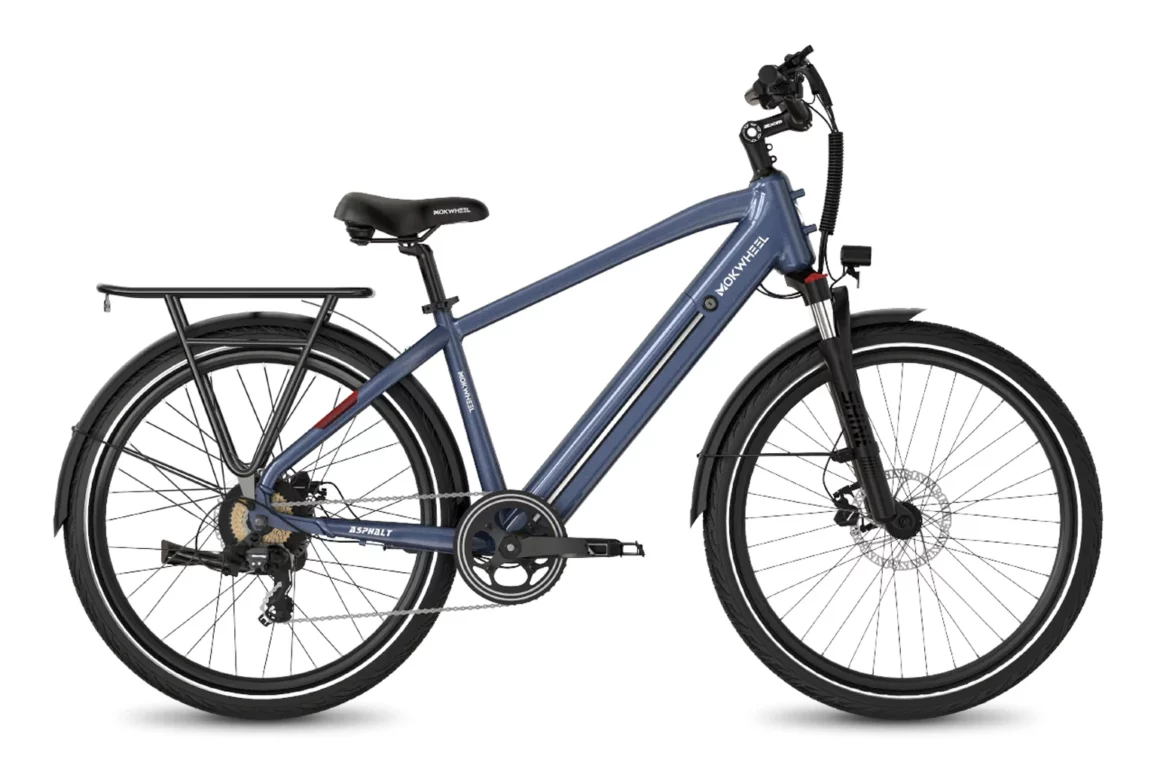
Mokwheel Asphalt
What We Like
- 60-mile range, perfect for long commutes
- Ideal for urban commuting with a comfortable upright posture
- Perfect for heavy-traffic commutes with thoughtful safety features
- Full-coverage fenders and integrated lights enhance practicality
- 27.5" x 2.4" tires for stability and smooth ride
What We Don't Like
- Weight and size might be challenging for some riders
- Not suitable for riders under 5'6" due to frame size
Overview of the Storm
The Mokwheel Asphalt emerges as an excellent choice for those seeking a reliable and comfortable e-bike for city commuting. Priced affordably under $1,500, it offers a compelling blend of functionality and style. With a 500W motor and a large 48V 14.7Ah battery, it promises up to 60 miles of range although we found it to be just shy of this during testing. But it still makes it ideal for longer urban journeys.
The bike’s design prioritizes rider comfort, featuring swept-back handlebars for a relaxed posture. Its stout frame and comprehensive safety features, including integrated lights and loud horn, are well suited for the bustling city environment. The Asphalt’s practical additions like full-coverage fenders and a sturdy rear rack make it a practical choice for daily commuters.
Bottom Line
The Mokwheel Asphalt is a standout option for urban commuters looking for an e-bike that combines comfort, functionality, and affordability. It’s well-suited for navigating city streets, offering a smooth and stable ride with enough range to handle long commutes with ease. While its size and weight may be considerations for some, its overall value and performance make it a top choice for city riders.
Best E-Bikes for Long Commutes (continued)

DŌST Kope CVT
What We Like
- Exceptional 120-mile range with dual battery option
- Versatile Enviolo CVT transmission for optimal riding comfort
- Class 1, 2, or 3 configurations for diverse use
- Low maintenance with carbon belt drive and sealed hub
- 750W mid-drive motor for powerful and efficient performance
What We Don't Like
- Additional cost for the dual battery option
- Remember, extra battery means extra weight
Overview of the Kope CVT
A new standard is set by the DŌST Kope CVT in the mid-priced long-distance e-bike market. Its innovative Enviolo CVT gearing system allows for seamless transition across an infinite range of ratios, making it ideal for tackling various terrains. Coupled with a 750W mid-drive motor, it provides ample power for long commutes and trekking.
The bike’s dual battery option nearly doubles its range to an impressive 120 miles, though this comes with an additional cost and weight. Designed for comfort and efficiency, the Kope CVT includes a Dost Air fork with 100mm travel, enhancing ride smoothness. Priced at just over $5,500 with the dual battery and extended warranty, it offers excellent value for those seeking a reliable, long-range commuting solution.
Bottom Line
The DŌST Kope CVT is a top pick for long-distance commuters and trekking enthusiasts, offering a powerful motor, innovative CVT transmission, and an extensive range. Its efficient performance and low maintenance design justify the investment, especially for those serious about their riding experience.
Best E-Bikes for Long Commutes (continued)
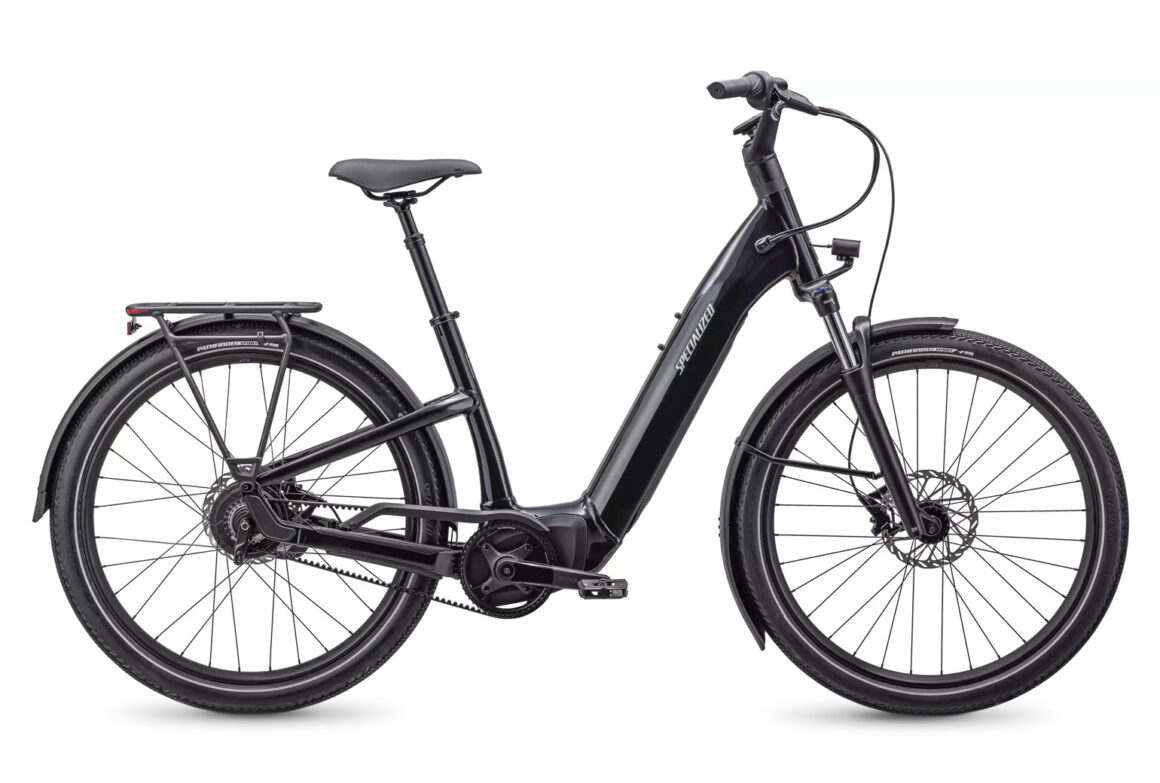
Specialized Turbo Como
What We Like
- Up to 90-mile range, excellent for long commutes
- Belt-driven drivetrain means low to no maintenance
- Comfort-focused design with suspension seatpost and higher volume tires
- Integrated theft prevention features for added security
- Light and maneuverable at 47.2 lbs, ideal for city riding
What We Don't Like
- Rear kickstand not ideal for soft surfaces
- Doesn't have a throttle, which is a nice option to have when commuting
Overview of the Turbo Como
The Specialized Turbo Como series offers an entry-level e-bike perfect for daily commutes and relaxed urban biking. The Turbo Como 5.0 stands out with a top speed of 28 mph and features like the Turbo Full Power 2.2 motor and Shimano Deore XT hydraulic brakes.
It’s designed for security with a removable and lockable battery and a motor that can be disabled via the Specialized app. Weighing just 47.2 lbs and available in multiple sizes, it caters to a wide range of riders. The Turbo Connect LCD Display and Specialized Mission Control app enhance the riding experience by allowing customization of power output and ride planning.
Bottom Line
The Specialized Turbo Como is a great fit for those prioritizing comfort and security in an urban e-bike. With its impressive range and thoughtful design, it’s suited for both beginners and experienced riders. While it requires some maintenance and carries a higher price, its range of models and features make it a versatile and appealing choice for city commuters.
Best E-Bikes for Long Commutes (continued)
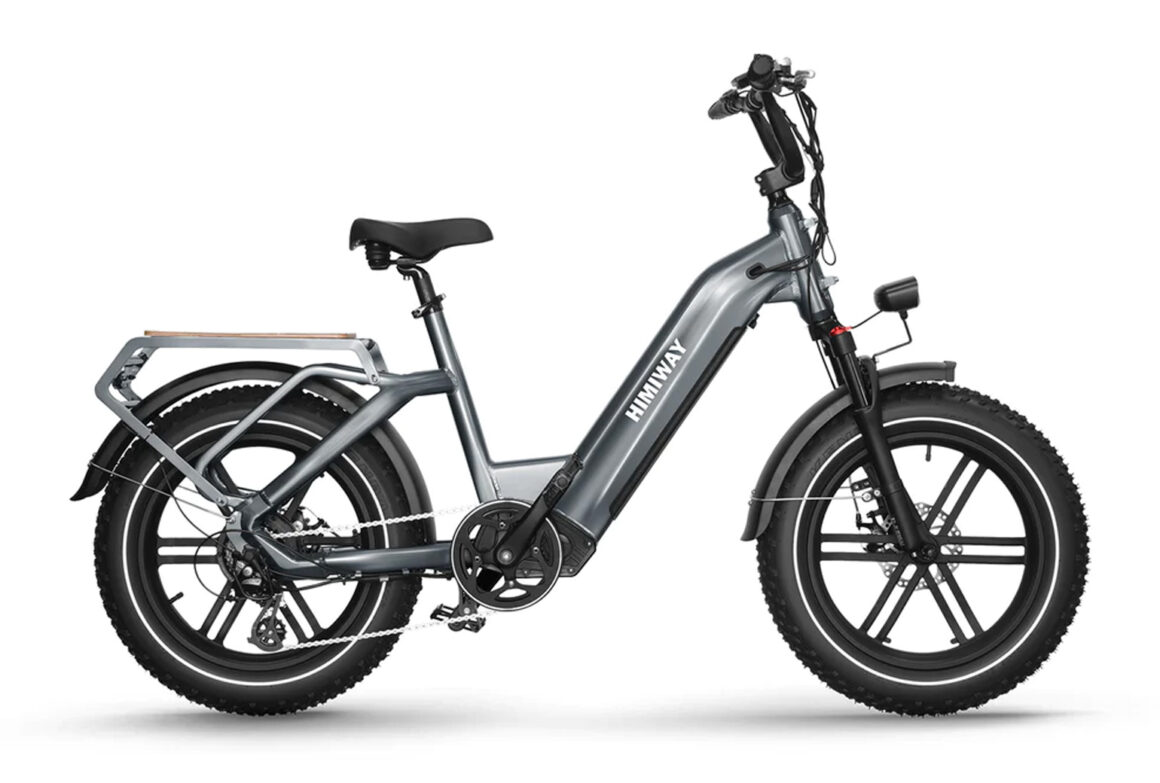
Himiway Big Dog
What We Like
- 80-mile range
- Sturdy frame with a 400 lbs carrying capacity
- 20"x4" Kenda fat tires suitable for all terrains
- Step-thru frame caters to a wide range of rider heights
- Integrated LCD display with USB charging for convenience
What We Don't Like
- Less suitable for very tall rider due to its frame design
- Heavier at 79 lbs, impacts chance for greater range
- Design may not appeal to all, focusing more on utility than style
Overview of the Big Dog
The Himiway Big Dog is a premium cargo e-bike designed to balance functionality and comfort. Upgraded from the Himiway Escape Pro, it features a powerful 750-watt gear motor and a heavy-duty frame. Its 48V 20Ah Samsung/LG lithium battery provides a long range, making it perfect for urban biking, errands, and deliveries.
The bike’s fat tires ensure a smooth ride across different terrains, even though they do likely negatively impact the overall range versus if they had a smoother tread or narrower profile. Its 400 lbs load capacity is ideal for carrying some pretty massive loads. The step-thru frame accommodates riders of varying heights, adding to its versatility even more. At $300 higher than its predecessor, the Big Dog offers an excellent value.
Bottom Line
The Himiway Big Dog is a solid choice for those who need a reliable and sturdy cargo e-bike for everyday use. Its combination of long-range, high load capacity, and all-terrain capability makes it a practical option for a variety of purposes, from commuting to running errands. While its design prioritizes function over style, it delivers in terms of performance and utility.
Have a shorter commute?
Longest Range Fat-Tire E-Bikes
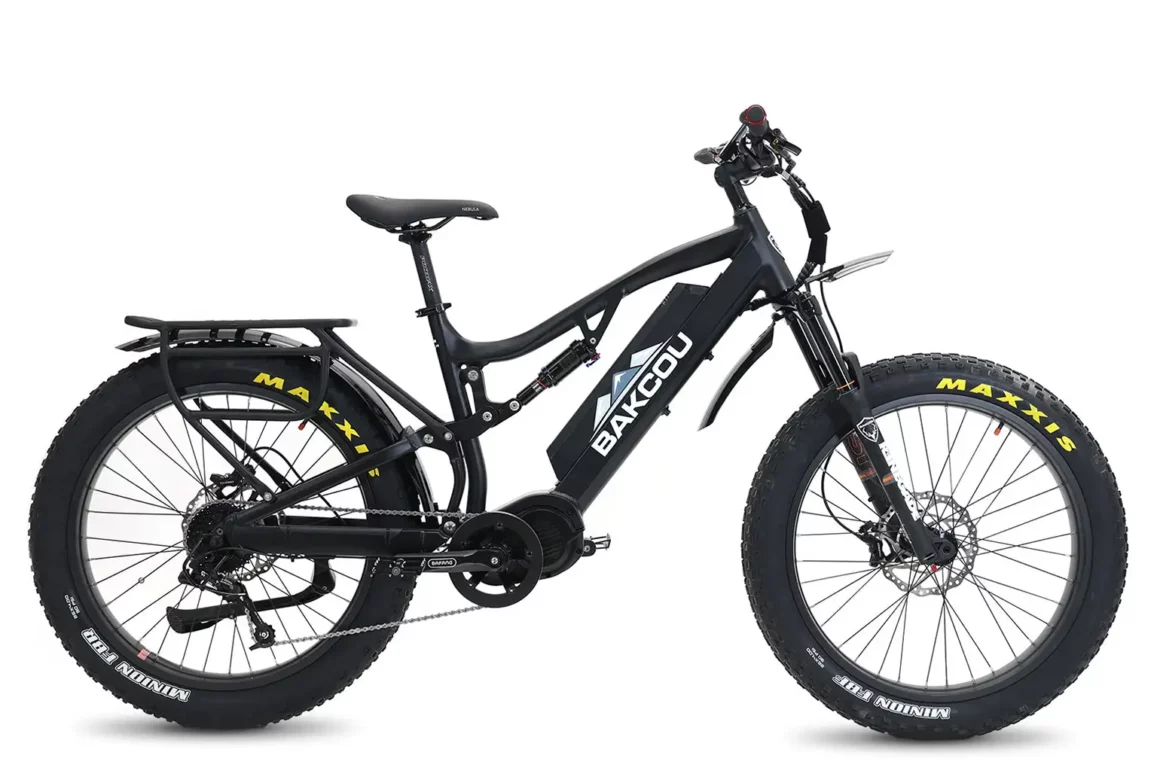
Bakcou Storm
What We Like
- Exceptional torque up to 160 Nm for challenging terrains
- Impressive 82-mile range for extended trips
- Dual suspension for comfort on rugged ground
- Powerful Bafang Ultra mid-drive motor
- Large payload capacity, suitable for hunting and camping
What We Don't Like
- Heavy at 82 lbs certainly impacts the range
- More wear and tear on the chain due to high power output
- Limited to slower-paced overlanding rather than fast downhill
- The motor can be too powerful for novice riders
Overview of the Storm
The Bakcou Storm stands out as a formidable player in the long-range fat-tire e-bike segment. Designed for all-terrain use, it boasts a Bafang Ultra mid-drive motor, capable of reaching speeds up to 35 mph and delivering up to 160 Nm of torque.
This bike is tailored for outdoor enthusiasts who enjoy hunting, camping, or fishing in remote areas. It comes with a choice of four battery sizes, ensuring a range suitable for whatever your needs may be. Along with its fat tires, the dual-suspension system, including a 120 mm travel RST Renegade air fork and a Rockshox Monarch rear shock, guarantees comfort even on the roughest trails.
Bottom Line
The Backou Storm is a powerhouse, ideal for those who seek adventure off the beaten path. Its combination of power, range, and rugged build makes it a top choice for outdoor activities where reliability and endurance are key.
Longest Range Fat-Tire E-Bikes (continued)
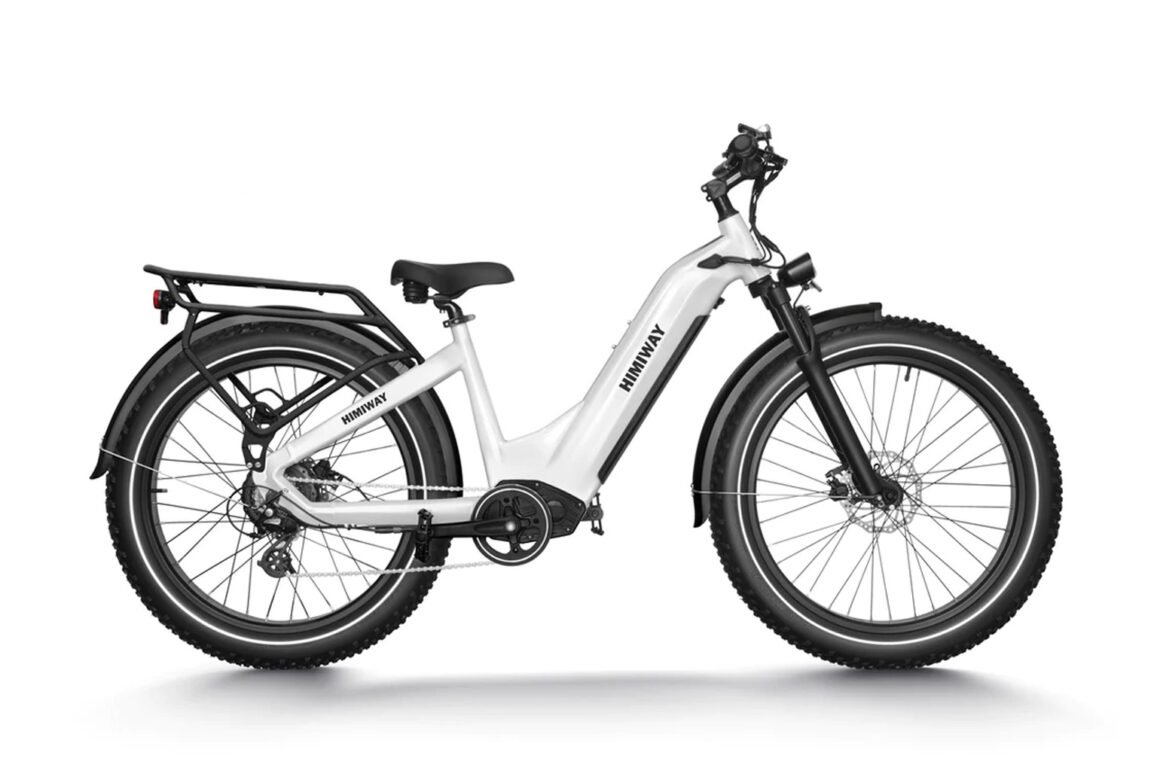
Himiway Zebra
What We Like
- Versatile for urban biking and light off-road use
- Impressive 80-mile range for long trips
- Comfortable for riders of varying heights
- 26" x 4" Kenda fat tires for ample traction
- Includes practical features like rear rack and USB port
What We Don't Like
- Not suited for technical off-road conditions
- Slightly dated design compared to modern e-bikes
- Heavy weight of 79 lbs affects maneuverability
Overview of the Himiway Zebra
An upgraded version of the popular Himiway Cruiser, the Himiway Zebra, brings together a balance of power, comfort, and versatility. It’s particularly suited for long urban rides and commuting, offering a reliable 80-mile range with its 48V 20AH Samsung/LG battery. The bike’s 750W motor, combined with its fat tires, provides a stable and cushioned ride across various terrains, though it’s best suited for lighter off-road conditions.
We found that the Zebra’s frame accommodates a wide range of rider sizes and includes thoughtful features like hydraulic disk brakes, an integrated battery, and an LCD display with a USB port, enhancing its overall usability and appeal.
Bottom Line
The Himiway Zebra stands out as a strong contender in the long-range fat-tire e-bike category, especially for those looking for an affordable option. Its combination of range, comfort, and user-friendly features make it a great choice for everyday urban riders and those venturing on light off-road paths.
Longest Range Fat-Tire E-Bikes (continued)
QuietKat Jeep Rubicon
What We Like
- 63-mile range for extended wilderness adventures
- 1,000W Bafang Ultra motor for on-demand power
- Durable CST 26" x 4.8" fat tires for versatile off-road use
- Comfortable ride with 140mm rear and 150mm front suspension
- Suitable for heavy payloads up to 300 lbs
What We Don't Like
- Heavy at 75 lbs, impacts maneuverability and range
- Overpowered for legal road use, primarily off-road
Overview of the QuietKat Jeep Rubicon
This premium electric bike is designed for the adventurous at heart. Equipped with a robust 1,000W Bafang Ultra motor and a substantial 1 kWh battery, it offers a blend of power and range ideal for overlanding, hunting, and wilderness camping. Its long-travel suspension and large fat tires ensure a comfortable and reliable ride in diverse off-road conditions.
Though heavy, the bike’s design ensures a balanced weight distribution, providing a natural riding feel. The Jeep Rubicon, with its superior build and features, is tailored for those who seek thrill and functionality in their off-road explorations.
Bottom Line
The QuietKat Jeep Rubicon is a top-tier choice for serious outdoor enthusiasts. Its powerful motor, extensive range, and rugged design make it a standout option for overlanding and other wilderness activities. While it commands a premium price, it delivers performance and durability that justify the investment for dedicated adventurers.
Looking For More Fat-Tire E-Bikes?
Best Long-Range Cargo Electric Bike
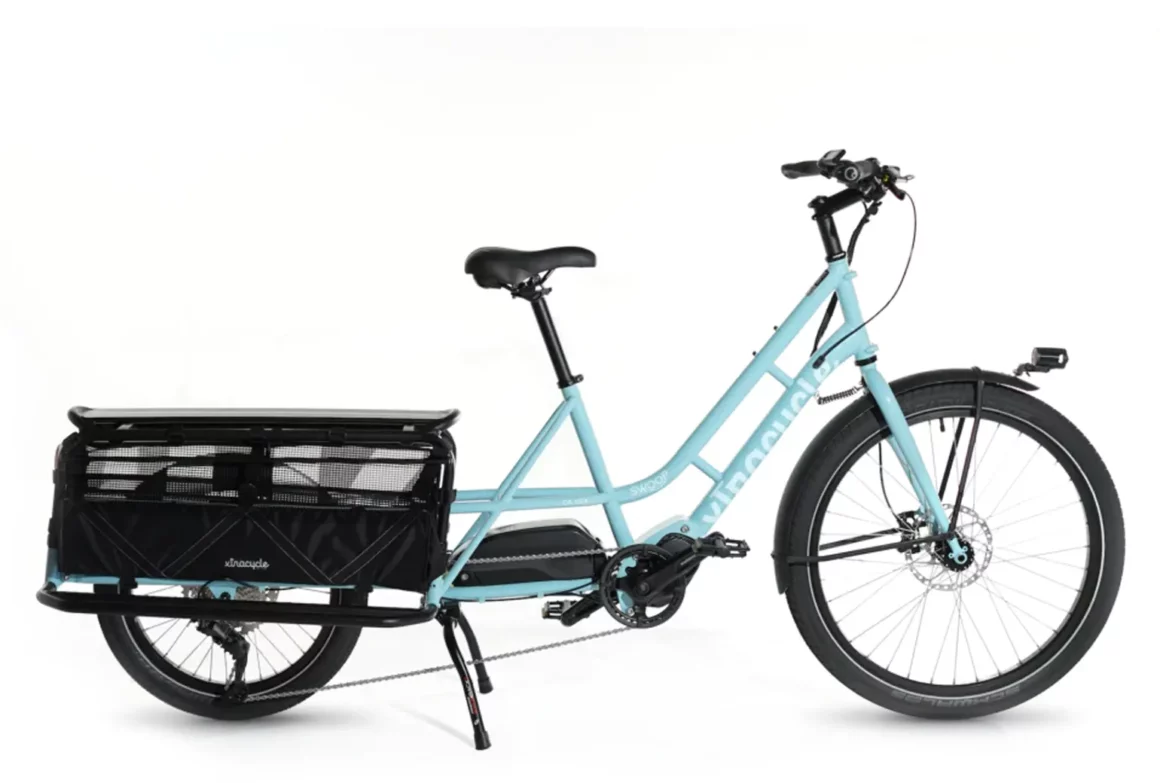
Xtracycle Swoop
What We Like
- Long 60-mile range suitable for many family or cargo needs
- Stable and strong 4130 Chromoly steel frame
- Versatile rear rack compatible with a ton of accessories
- Premium build-quality and components means this bike will last forever
What We Don't Like
- Long battery charging time of over 10 hours
- Would love to have a throttle option
- May require professional assembly for optimal setup
Overview of the Xtracycle Swoop
The Xtracycle Swoop is a highly versatile and durable cargo e-bike, designed to serve as a practical alternative to a car for family and cargo transportation. Its 4130 Chromoly steel frame provides exceptional strength, allowing it to carry up to 400 pounds, including the rider. The Swoop is equipped with a Shimano 630 Wh battery, offering a substantial range of up to 60 miles, though the charge time is relatively long.
It features an 11-speed SRAM GX cassette and a Shimano EP8 mid-drive motor, delivering smooth and efficient power for different riding conditions. This bike’s unique wheel setup, with a 26-inch front and 20-inch rear wheel, enhances its cargo-carrying capabilities, making it a reliable choice for serious cargo haulers.
Bottom Line
The Xtracycle Swoop is an excellent investment for those needing a reliable, long-range cargo e-bike. Its combination of durability, versatility, and substantial carrying capacity makes it an ideal choice for families and those who require a dependable mode of transportation for all sorts of cargo needs. The Swoop also makes our list of Best Cargo E-Bikes, because it’s just that good!
Best eMTBs for Long Rides
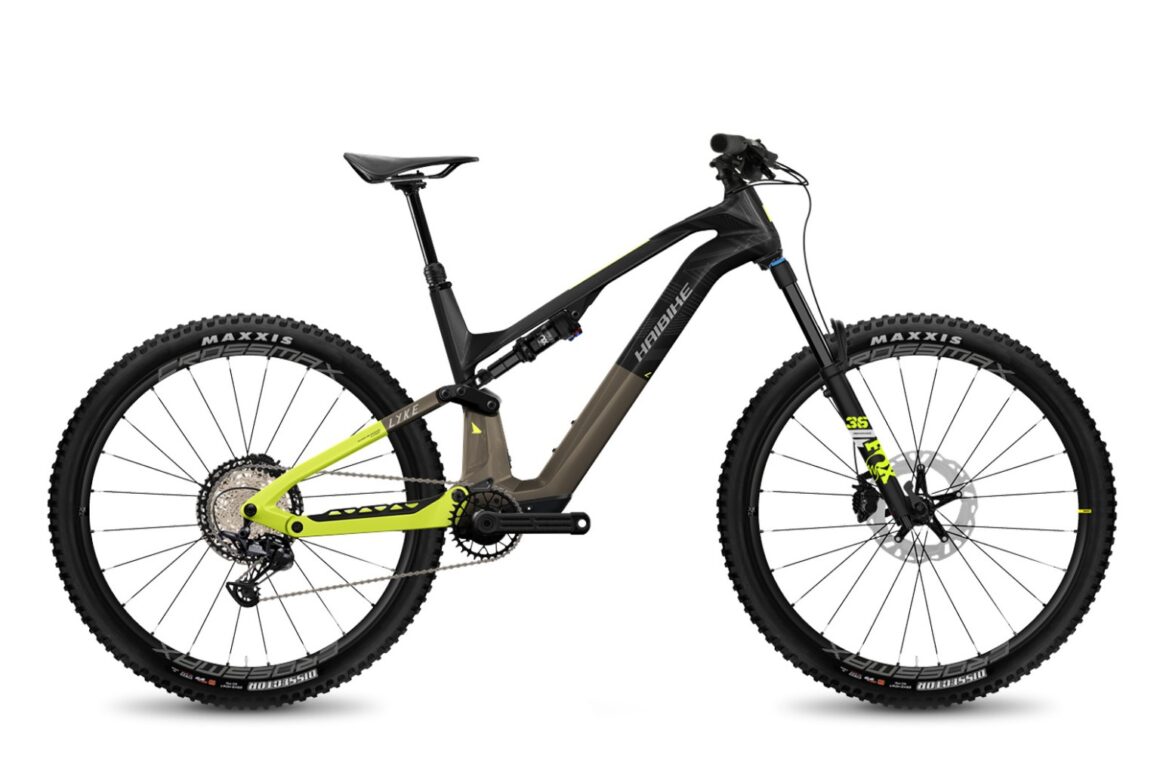
Haibike Lyke CF 11
What We Like
- Lightweight design at just under 42 lbs enhances off-road agility
- Fazua Ride 60 motor with unique "boost" mode for tough climbs
- 40-mile range suitable for extended off-road adventures
- High-quality Fox suspension system for comfortable rides
- Light carbon frame and Mavic Crossmax wheels
What We Don't Like
- Price may be high for some budgets
- Limited battery capacity compared to full-power eMTBs
- Requires more rider effort on technical climbs
- May not suit riders looking for a motor-dominant experience
Overview of the Lyke CF 11
The Haibike Lyke CF 11 is a standout in the lightweight eMTB category, designed for riders transitioning from traditional bikes to electric mountain bikes. It features a carbon frame, integrating a 430 Wh battery and a Fazua Ride 60 motor, offering a blend of power and lightness. The bike excels in delivering a traditional mountain biking feel with just enough electric assistance.
Equipped with a Fox 36 fork and Float shock, it handles tough terrains smoothly. The Lyke CF 11’s mid-level travel and 29” wheels make it ideal for experienced riders seeking a balance between an electric boost and the natural ride feel of a traditional mountain bike.
Bottom Line
The Haibike Lyke CF 11 is an excellent choice for those who want the benefits of an eMTB without compromising on the lightweight, agile experience of a regular mountain bike. Its advanced motor system, high-quality components, and sleek design make it a top contender. While it demands a higher price and more rider input on climbs, its performance, style, and innovation justify the cost for those seeking a superior eMTB experience.
Best eMTBs for Long Rides (continued)
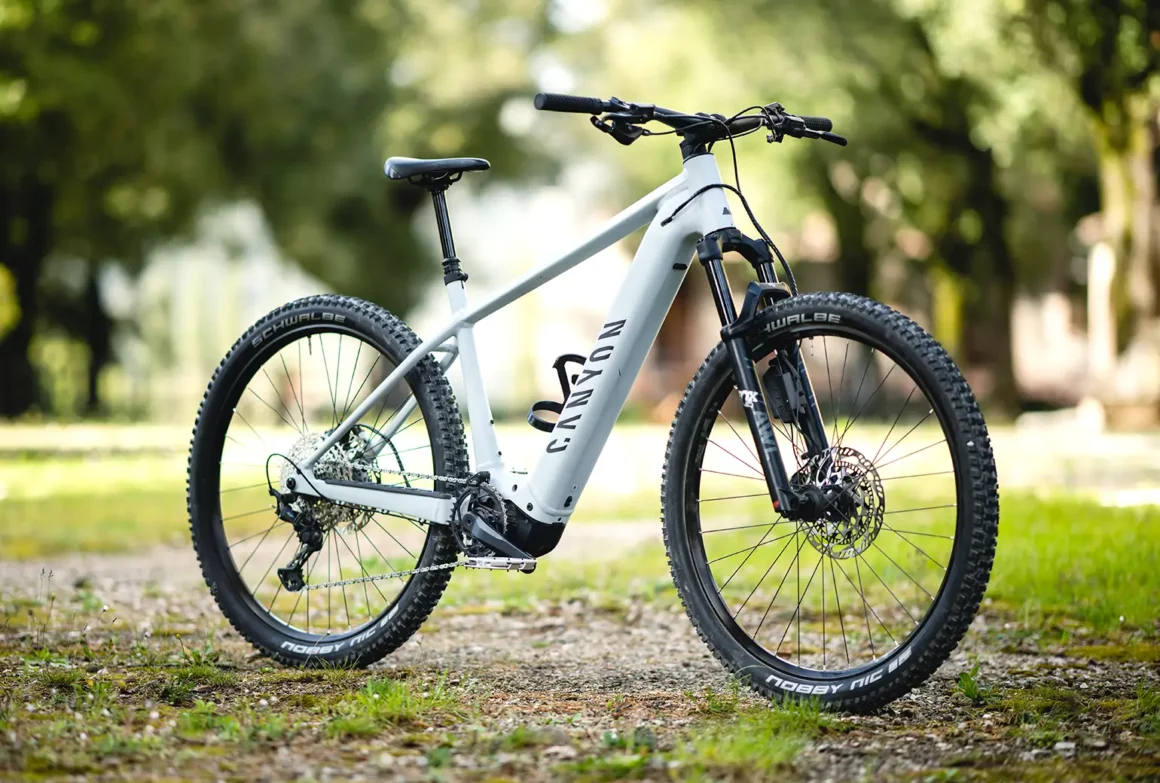
Canyon Grand Canyon:ON
What We Like
- Bosch Generation 4 Performance CX motor for powerful off-road performance
- 750Wh Bosch battery provides a 50-mile range
- ABS braking system for enhanced safety on gravel and rough terrains
- Lightweight aluminum frame for easy maneuverability
- Versatile for various riding styles, from urban to light trails
What We Don't Like
- Battery charging in the frame, limiting flexibility
- Not suitable for extreme off-road or aggressive riding
- Bike's upright position may not appeal to aggressive trail riders
Overview of the Grand Canyon:ON
The Canyon Grand Canyon:ON is an innovative eMTB that combines off-road capability with comfort and style. It features a Bosch Generation 4 Performance CX motor, delivering robust power for off-road excursions. The integrated 750Wh Bosch battery offers a significant 50-mile range, making it suitable for long rides and explorations.
Designed with safety in mind, it includes Bosch’s latest ABS braking system, providing reliable stopping power on varied terrains. The bike’s 29” front and rear wheels, coupled with the Fox 34 AWL fork, ensure a smooth ride over diverse landscapes.Its aluminum frame maintains a sleek profile while housing the large battery, and the bike’s overall design caters to a wide range of riders, from those exploring urban environments to adventuring on mild trails.
Bottom Line
As a versatile and stylish eMTB, the Canyon Grand Canyon:ON can handle both urban settings and light trail adventures. Its combination of a powerful motor, substantial battery range, and advanced braking system makes it a top choice. While it may be a significant investment, the Grand Canyon:ON offers the reliability, safety, and capability to make it a worthwhile choice for both novice and experienced riders alike.
Best eMTBs for Long Rides (continued)
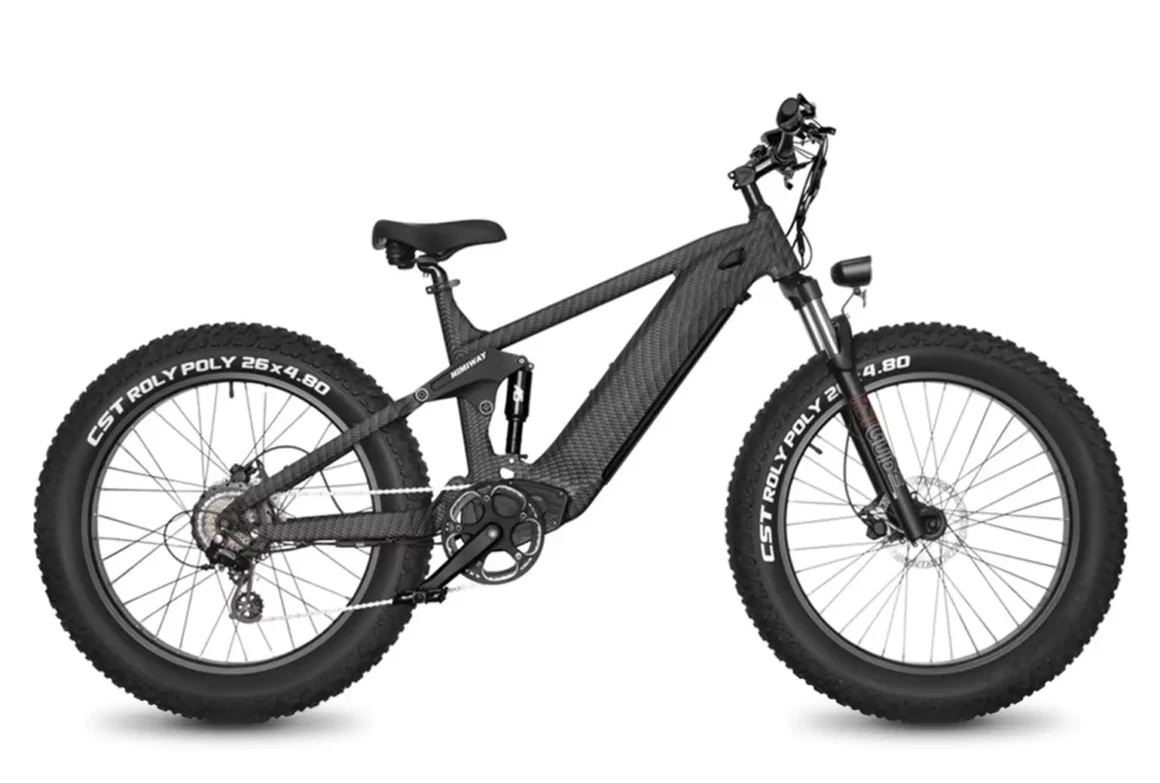
Himiway Cobra
What We Like
- 63-mile range, ideal for extended off-road adventures
- Powerful 750W motor with 86 Nm torque for steep inclines
- 400 lbs payload capacity, suitable for hunting or camping gear
- 26” x 4.8” fat tires for excellent traction and comfort on rough terrains
- Dual suspension system for a smooth ride in rugged conditions
What We Don't Like
- Heavy at 88 lbs, which surely impacts greater range
- Limited high-end components may impact long-term durability
- Not designed for aggressive singletrack or downhill riding
Overview of the Cobra
We find the Himiway Cobra to be a robust and versatile electric mountain bike designed for overlanding, hunting, and wilderness camping. It features a 750W rear hub motor capable of reaching speeds up to 25 mph with pedal assist, and its substantial 960 Wh battery offers an impressive range for deep backwoods exploration.
The Cobra’s design includes a dual suspension system and fat tires, ensuring stability and comfort on varied terrains. It’s particularly suited for riders seeking an off-road e-bike capable of handling heavy loads, making it an excellent choice for outdoor enthusiasts.
Bottom Line
The Himiway Cobra’s combination of long-range, high payload capacity, and mighty construction make it perfect for riders looking to venture into the wilderness or go on long off-road tours. While its size may not appeal to smaller riders or those seeking a more agile experience, its overall performance and capabilities make it a great choice for a reliable, long-range eMTB.
Long-Range E-Bikes for Kids
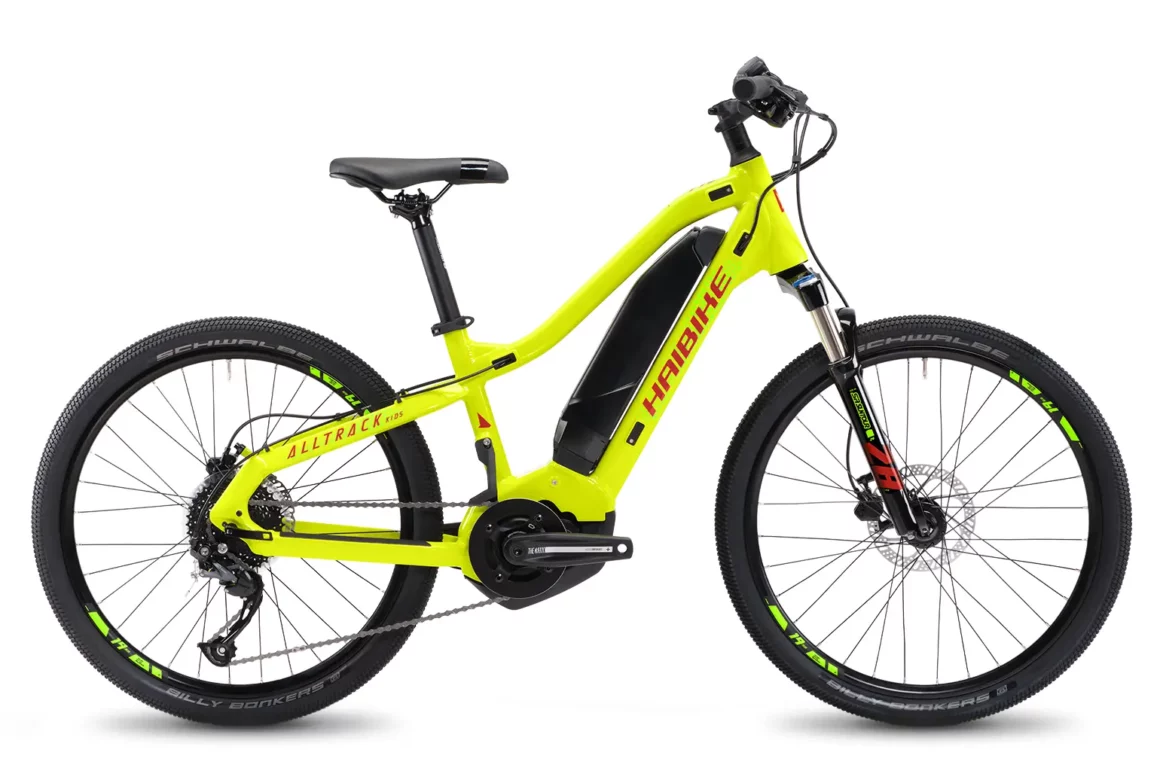
AllTrack Kids
What We Like
- Yamaha PW-TE mid-drive motor, perfect for young riders' trail adventures
- 400 Wh battery offering up to 30 miles of range
- 24” wheels and 63mm travel fork, perfect for young riders
- Quality Tektro and Shimano components for reliable performance
- Lightweight and agile, making it easy for kids to handle
What We Don't Like
- Motor can create drag when pedaling without power, possibly tiring for kids
- Limited availability in the U.S., challenging to source state-side
- Not suitable for very aggressive off-road riding
Overview of the AllTrcks Kids
The AllTrack Kids by Haibike is a superbly designed electric mountain bike tailored for children. It comes equipped with a reliable Yamaha PW-TE mid-drive motor, providing enough power for overlanding and trail riding adventures. The bike’s 400 Wh in-tube Yamaha battery offers a decent range, ideal for extended rides with the family.
This hardtail eMTB has kid-friendly features, including 24” wheels and SR Suntour suspension fork with 63mm travel, ensuring a comfortable and safe ride for youngsters. Despite its limited availability in the U.S., the AllTrack Kids stands out for its build quality and design and is an excellent introduction to trail riding. If you can get your hands on it in the States, it’s a definite must.
Bottom Line
The Haibike AllTrack Kids is the perfect eMTB for young riders, blending a strong Yamaha motor, substantial range, and kid-friendly features. Its superior quality and design make it a valuable investment for children’s introduction to trail riding, offering up a safe and exhilarating outdoor experience.
Long-Range E-Bikes for Kids (continued)
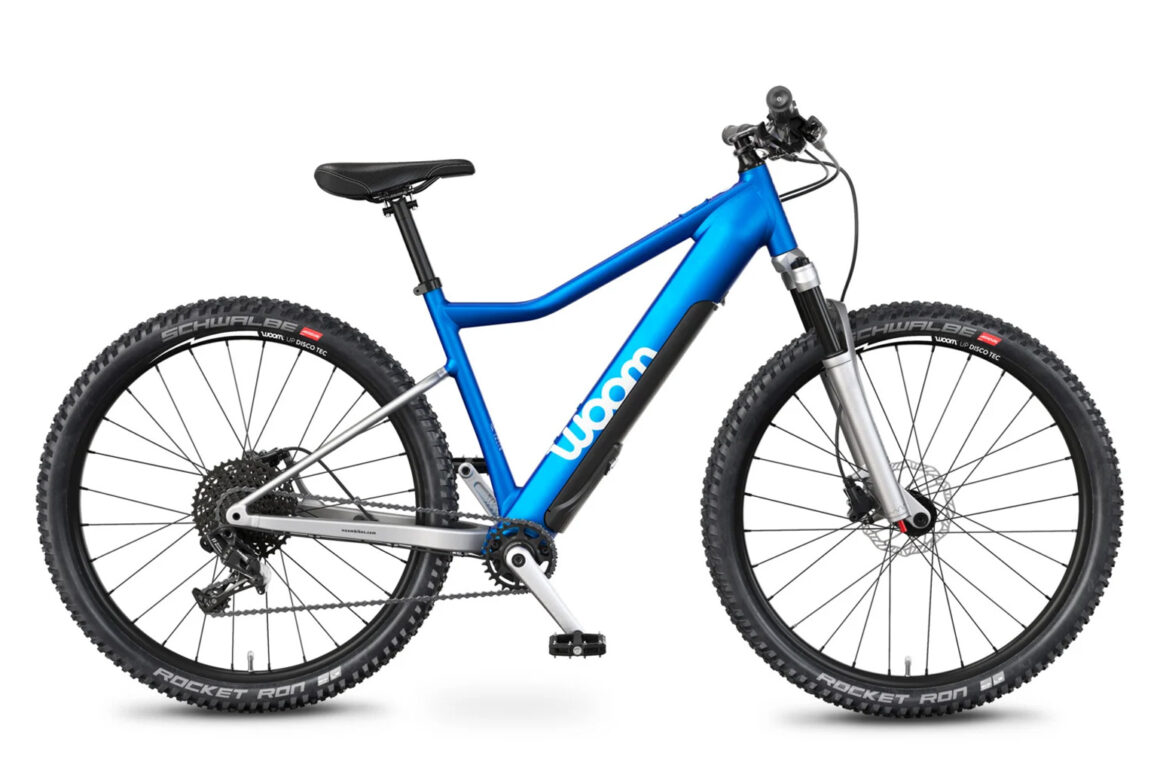
Woom UP 6
What We Like
- Ergonomically designed for kids, ensuring a comfortable fit
- Lightweight Fazua Evation motor system, ideal for young riders
- Removable motor and battery for versatile use
- Durable 6061 aluminum frame suitable for trail riding
- Three levels of pedal assist with a top speed of 12 mph
What We Don't Like
- Motor gives some resistance when off, which could be challenging for little riders
Overview of the Woom UP 6
The Woom UP 6 is a thoughtfully designed eMTB perfect for kids aged 10 to 14 years, offering a blend of safety and adventure. It features a Fazua Evation 250W mid-drive motor, known for minimal resistance, and a 250 Wh battery, ideal for a range of up to 20 miles. With ergonomic design elements like a kid-friendly saddle, handlebars, and brake levers, it ensures a comfortable and enjoyable ride. Its 26-inch tires and SRAM NX 11-speed drivetrain make it capable of handling various terrains, making it an excellent choice for introducing young riders to mountain biking.
Bottom Line
We recommend the Woom UP 6 because it is an exceptional entry-level eMTB for kids, offering a perfect balance of safety, comfort, and off-road capability. Its kid-centric design and quality components provide a great introduction to mountain biking. While it’s a significant investment, its value in fostering a love for biking and outdoor activity in children is endless.
Folding E-Bikes with the Longest Range
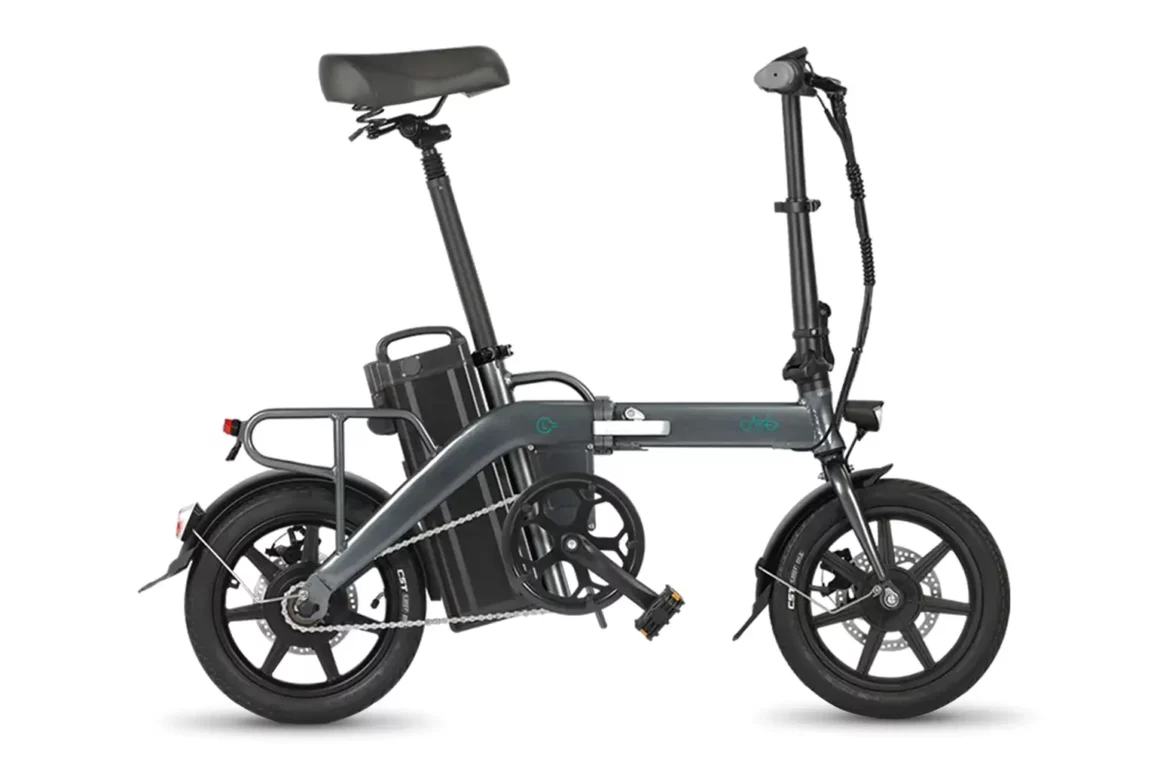
Fiido L3 Long Range
What We Like
- Remarkable 120-mile range with a 1,113 Wh battery
- Compact folded size ideal for small spaces and transport
- Adjustable for a wide range of rider heights (5' to 6'5")
- Affordable pricing for a long-range folding e-bike
What We Don't Like
- Motor can create drag when pedaling without power, possibly tiring for kids
- Small 14” wheels can affect riding comfort on rougher roads
- Lacks suspension, making rides less smooth on uneven surfaces
Overview of the L3 Long Range
We like the Fiido L3 Long Range for its exceptional battery life, super-long range, and compact design. It’s a game-changer for those needing a long-range, portable bike, especially for apartment living, commuting, or traveling in RVs. Its foldability, coupled with an impressive range, makes it a versatile and practical choice. However, we feel its small wheels and lack of suspension might compromise comfort, especially on longer rides.
Bottom Line
The Fiido L3 Long Range is an excellent choice for anyone seeking a folding e-bike with an extended range at an affordable price. While it may not be the fastest or most comfortable for very long rides, its compact size, and long battery life make it an excellent solution for urban commuters, travelers, and those with limited storage space.
Folding E-Bikes with the Longest Range (continued)
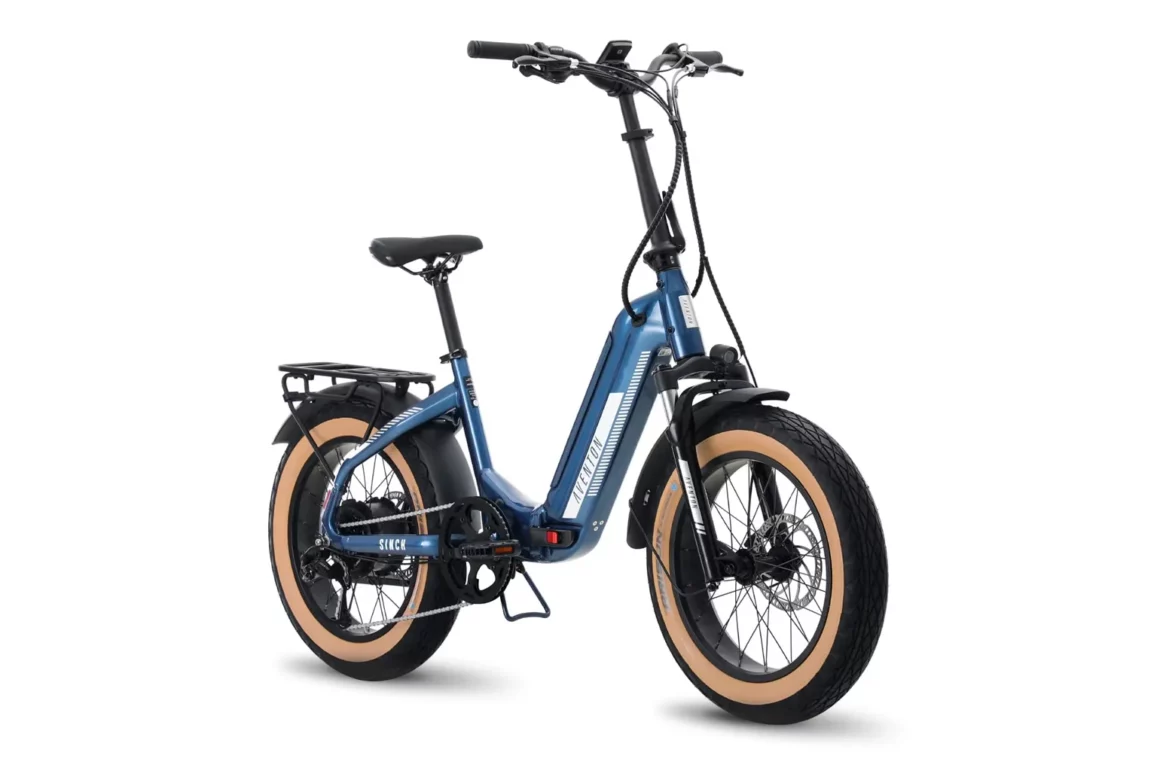
Aventon Sinch.2
What We Like
- Excellent 55-mile range with a 750W peak motor
- Versatile for both urban commuting and off-roading
- Inclusive design fits riders from 4’11″ to 6’2″
- Folds easily for storage and transport, suitable for city living and traveling
What We Don't Like
- Heavier at 68 lbs, which may be challenging for frequent carrying
- Some users may find the right side of the handlebars crowded
- Absence of Class 3 capabilities found in other Aventon models
Overview of the Sinch.2
The Aventon Sinch.2 is a winner in our book because it’s a versatile and dynamic folding e-bike, perfect for both city commutes and light off-road adventures. It’s a great option for those looking for a blend of power, portability, and inclusive design. With a wide height range accommodation and a robust motor, it caters to a variety of riders. However, we understand that its weight might limit its appeal to certain users.
Bottom Line
We think the Sinch.2 is ideal for riders seeking a foldable e-bike that doesn’t compromise on range and power. While it may be heavier and lack some advanced features, its adaptability, ease of storage, and inclusive design make it a strong contender, especially for urban dwellers and outdoor adventure seekers.
Folding E-Bikes with the Longest Range (continued)
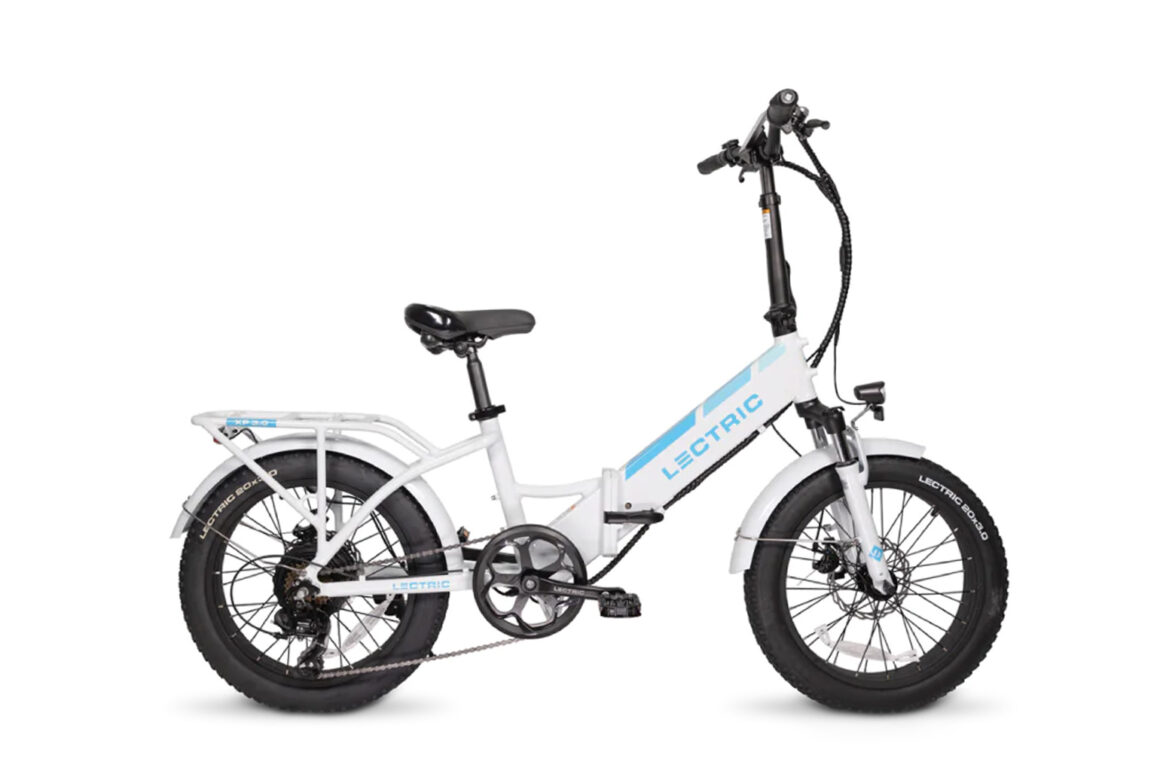
Lectric XP Step-Thru 3.0
What We Like
- 65-mile range with a powerful 500W motor
- Class 3 capabilities, offering speeds up to 28 mph
- Foldable design, ideal for RV-ing, camping, and compact storage
- Unique passenger-carrying option with a speed-limiter for added safety
What We Don't Like
- Heavy at 64 lbs, which might be challenging for frequent carrying
- More utility than form, built to be affordable
Overview of the XP Step-Thru 3.0
As a versatile folding e-bike we find that the Lectric XP Step-Thru 3.0 excels in providing long-range mobility with the convenience of a foldable design. It’s an excellent choice for outdoor enthusiasts, RV travelers, and those seeking a reliable electric bike for leisurely adventures. The ability to carry a passenger makes it stand out in the folding e-bike segment.
Bottom Line
The Lectric XP Step-Thru 3.0 is a great fit for those looking for a foldable e-bike that offers both range and speed. We get that it may be a bit heavy for some riders and less ideal for regular commuting, but its features like passenger carrying, off-road capability, and compact folding design make it a valuable companion for almost any ride.
FAQs About Long-Range E-Bikes
Q: In general, which class of e-bike gets the longest range?
Generally, Class 1 e-bikes, which offer pedal-assist without a throttle and have a motor that cuts out at 20 mph, tend to have the longest range. This is because they efficiently use the rider’s pedaling power in conjunction with the electric assist, conserving battery life more effectively than Class 2 or Class 3 e-bikes.
Q: What steps can you take to get the most range out of your e-bike?
- Maintain your e-bike, keeping it clean and lubricating the chain regularly.
- Inflate tires to the high-end of pressure range.
- Soft tires equal greater rolling resistance.
- Store the e-bike, or at least the battery, in a temperature-controlled environment.
- Practice gentle acceleration and use lower gears when starting to pedal.
- Choose routes wisely, opting for flatter and less congested paths.
- Minimize excess weight, both personal and cargo.
- Keep your battery charged, but avoid overcharging or leaving it at full charge for extended periods when you’re not riding it.
Q: Can environmental factors or terrain affect an e-bike’s range?
Yes, environmental factors and terrain do make an impact on an e-bike’s range. Extreme temperatures can reduce battery efficiency. Headwinds and tailwinds can either increase or decrease resistance, affecting battery consumption. Riding on hilly or rough terrain requires more power than flat, smooth surfaces, and wet conditions affect the friction between tires and the road, which can all put a dent in your range.
What to Look for When Shopping for Long-Distance Electric Bikes
When shopping for a long-range e-bike, understanding the balance between battery size, bike weight, and power efficiency is of utmost importance.
Here’s what makes a good long-range e-bike and what to look for:
Optimized Battery Size
While a larger battery can mean more range, it also adds weight. The best long-range e-bikes strike a balance, offering enough battery capacity for extended travel without excessively increasing the bike’s weight. Look for e-bikes with a range of over 60 miles per charge, which indicates a good balance between battery size and efficiency.
Power Efficiency
The key to long-range e-biking isn’t just a massive battery; it’s about how efficiently the bike uses its power. Efficient motor design, power management systems, and even the bike’s rolling resistance can influence how far you can go on a single charge.
Bike Weight
Heavier electric bikes require more power to move, which can drain the battery faster. Consider the overall weight of the e-bike, including the battery. Lightweight frames combined with a well-sized battery offer the best range-to-weight ratio.
Riding Modes and Assist Levels
Electric bikes with multiple riding modes and assist levels allow you to manage power usage better. Using lower assist levels on flatter terrain can significantly extend your range.
Terrain and Tire Design
The type of terrain you ride on impacts range. Fat tires or overly knobby tires, while great for stability, can reduce range due to increased rolling resistance. Choose tire designs that match your typical riding surfaces for the best range efficiency.
Charging Time vs. Range
Consider the charging time relative to the range offered. A bike that offers a long range but takes excessively long to charge may not be practical for daily use.
User Reviews and Real-World Performance
Manufacturer’s range claims are often based on “ideal” conditions. Look for user reviews and real-world tests to get a more accurate picture of what to expect in terms of range.
Guides to Help You Learn More
We understand that the world of electric bikes can be overwhelming, but don’t worry, we’ve got your back. We have compiled a list of resources that we believe will be useful to you. Take a look at them below:


